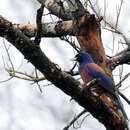Biology
(
англиски
)
добавил Arkive
Flocks of Amami jays can be found wandering through their preferred habitat, mature evergreen forest, searching for their main food source, acorns of the Castanopsis cuspidata tree. These flocks are generally small, but groups of up to 100 have been reported. It is rarely seen feeding in the trees, preferring instead to forage among leaf litter on the forest floor, and will often store the food it finds for the winter. As well as acorns, the Amami jay consumes sweet potato, insects and reptiles, such as grass lizards and the poisonous Okinawa pit-viper (3). The Amami jay breeds from late January until May, when it will lay three to four eggs in nests on low tree branches, in tree holes, or occasionally on the ground or on buildings. The adults protect small territories around the nesting site, and chicks fledge in mid to late March (3).
Conservation
(
англиски
)
добавил Arkive
The Amami jay is on the national Red List of Japan, and is legally protected as a National Endangered Species. It also occurs in three protected areas; Yuwangatake National Wildlife Protection Area on Amami, and Kinsakubaru and Kanengotake Prefectural Wildlife Protection Areas, established primarily for the conservation of the Amami jay and Amami thrush (Zoothera major). A number of surveys and ecological studies of this bird have been undertaken, but further research and monitoring is recommended. Surveys of the mountain region of Tokuno-shima to elucidate the causes of the bird's extinction there would be particularly beneficial, as this knowledge could be used to prevent the same occurring on other islands. The remaining areas of mature forest within its range need to be protected, and control of introduced mammals is equally vital to the survival of this beautiful bird (3).
Description
(
англиски
)
добавил Arkive
This stunning, richly coloured bird is found only on a few islands in Japan. Its plumage is a deep purplish-blue, with a velvety black forehead and a rich chestnut back and underparts. The flight and tail feather are tipped with white, and there is also white flecking on the throat. The bill has a grey-blue base and an ivory coloured tip (2). The Latin genus name of this bird, Garrulus, means talkative and chattering.
Habitat
(
англиски
)
добавил Arkive
Occurs primarily in subtropical evergreen broadleaved forest, particularly mature forest, but can also be found in coniferous forest and woodland around agricultural areas and human habitation, from sea level up into the hills (3).
Range
(
англиски
)
добавил Arkive
The Amami jay is found only on the Nansei Shoto islands in southern Japan, where it occurs on Amami-ooshima and Kakeroma-jima. It previously could be found on Tokuno-shima Island, but is now believed to be extinct there (2).
Status
(
англиски
)
добавил Arkive
Classified as Vulnerable (VU) on the IUCN Red List 2007 (1).
Threats
(
англиски
)
добавил Arkive
Historically, this species was threatened by hunting for the cagebird and feather trade, but today, the primary threat to the Amami jay comes from increased levels of predation. Large-billed crows, which prey on eggs and chicks, have recently increased in number, probably as a result of increased rubbish disposal on the islands. Several introduced mammals also prey on the Amami jay, including feral dogs, feral cats and the Javan mongoose, which was introduced for snake control. It is not yet known the impact that this increased predation may have on populations of Amami jay. An additional threat comes from habitat loss, as in the last few decades large areas of mature forest have been cleared. It is possible that deforestation was the primary cause of the Amami jay's extinction on Tokuno-shima Island (3).

